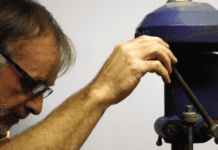There are probably two dozen topics in sailing that demand a bit of serious study, from navigation and meteorology to diesel mechanics, electrical troubleshooting-on and on.
A couple of the more rewarding topics to comprehend and manage are aerodynamics and hydrodynamics, often linked under the common name of fluid dynamics. For sailors, this is the science of how the hull and appendages move through the water, and how the sails move through the air, and the art of doing what we can to make things more efficient.
If you have no desire to make your boat move more efficiently; if you go around with blown-out, slatting, ill-trimmed sails, and fire up the engine at the first sign of air that’s too light, too heavy, or too ahead…well, you’re missing out. Like the so-called navigator who would be instantly lost without GPS, you’ll probably get where you’re headed, but where’s the skill, the mental connection to the elements? And thus, where’s the real fun?
At the Olympic level, fluid dynamics is the stuff of hard math and physics, chaos science, and computational horsepower, all complicated enough to have drawn plenty of serious boffins to sailing. There’s some charlatanism, and plenty of talkers-of-the-talk who use what grasp they have of the topic mainly to impress others, with the result that casual sailors often think that the science of sailing is beyond them, and unnecessary for enjoyment.
But at the mere mortal level, this stuff isn’t too tough. I’d argue that a grasp of basic fluid flow is pretty much essential for the enjoyment of the sport. Sailboats-especially cruising sailboats-are slow enough already. The least we can do is equip them with decent sails, keep their bottoms clean, and try to help them along.
Even if we can’t alter the shape of our hulls, we can trim them in the water properly, and we can certainly work on our sailshape. Good sailtrim isn’t a big mystery, but it takes some study to understand how a sail’s relationship to the air changes when we tighten a cunningham, or move a lead outboard, or cinch down the vang.
Once you grasp concepts like angle of attack, and attached flow versus separation, you can start to visualize what’s happening. Still, you need the right teacher and a few hours of spare time to read and absorb.
Finding time is the hard part, but when you can manage it, read Maximum Sail Power by Brian Hancock (Nomad Press). It arrived in our office about two weeks after we shipped our November 1 issue, regretful that after two big articles in two months about sails and sailmakers, we’d managed to cover a lot of the “what,” but nothing of the “why” and “how.”
Mr. Hancock is an ocean-racing sailmaker with vast experience and a very engaging pen, and his book is completely up to date on materials, techniques, and science. The fifteenth chapter alone is worth the price of admission. There, Hancock does a great job of distilling decades of accumulated knowledge about airflow from people like C.A. Marchaj, Arvel Gentry, and Tom Whidden. Spend an hour with that chapter, and you’ll be much better educated about your sails.
We split tacks only on the issue of whether it’s reasonable to expect a sailmaker to make a boat call (sails call?) these days, given the accuracy of measurement and automation available. He says it’s not cost-effective for the sailmaker or, by extension, the customer. I think that in many cases it’s not only reasonable, but vital-for the customer in the short run, and for the sailmaker in the long run, if he wants to educate cruising sailors enough to make them good, regular clients. It’s not so much the need to come aboard and see if a sail should be recut-it’s to show the customer how to use the product, how to know when to come back next time, and maybe, in doing so, show him something of where the pleasure in sailing really resides.
-Doug Logan



































